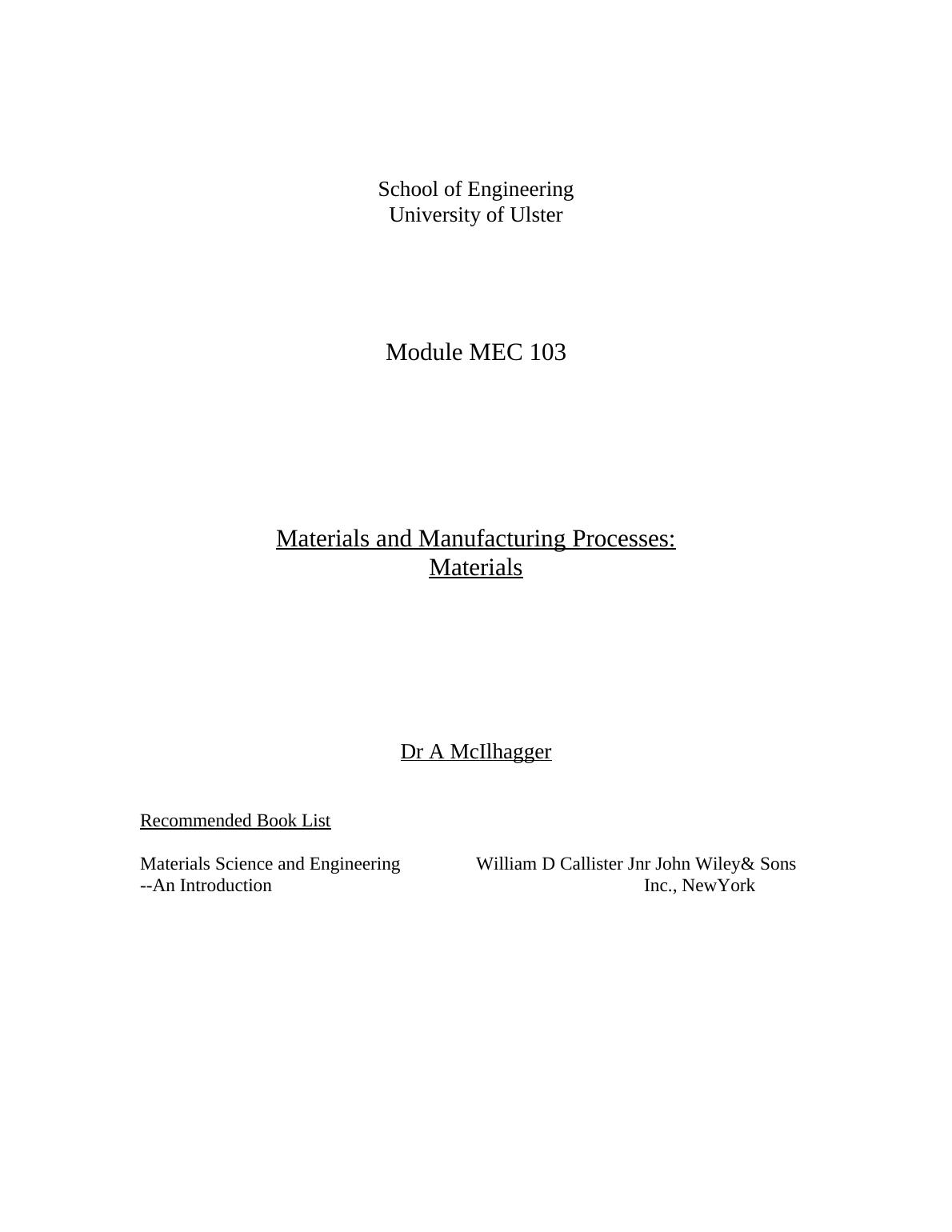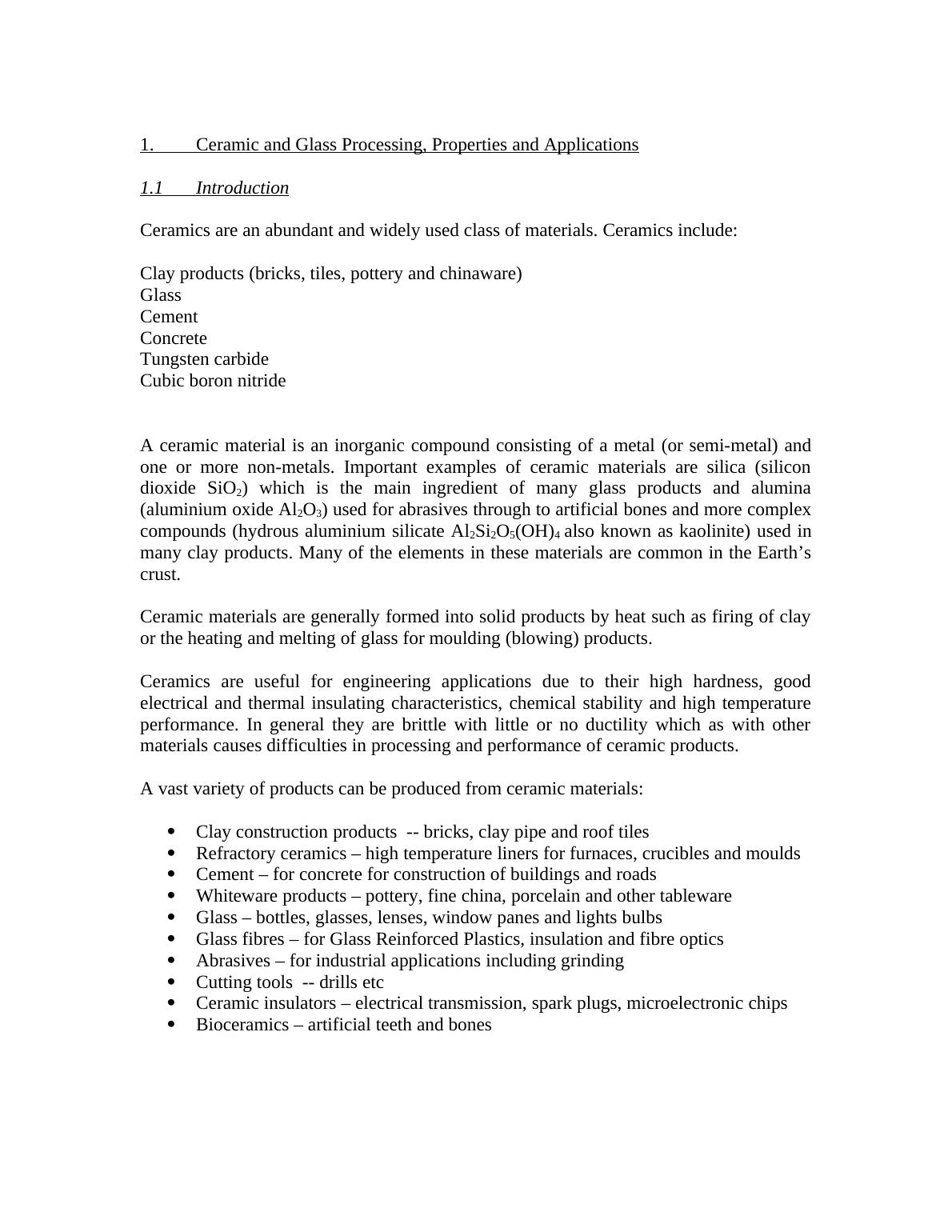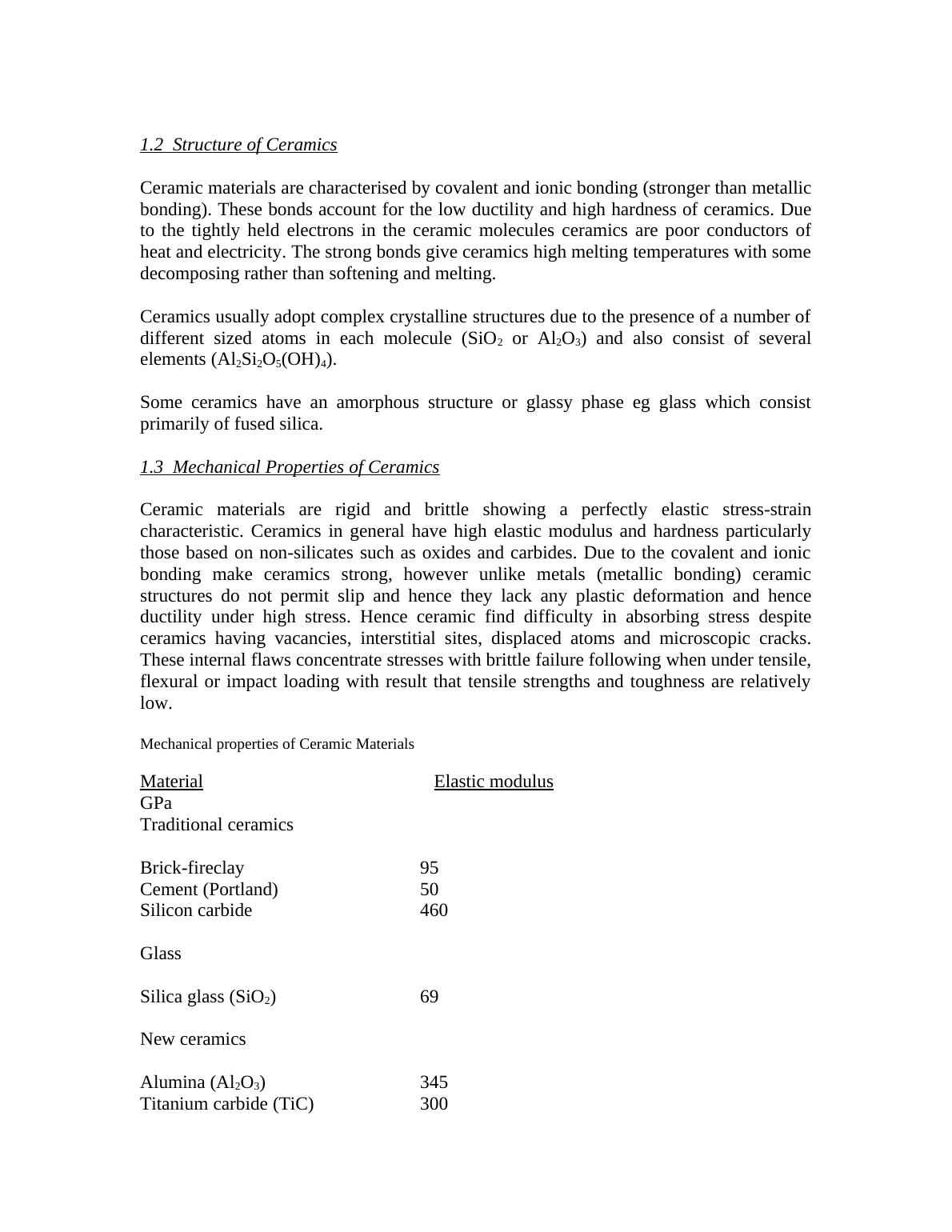Materials and Manufacturing Processes
Added on 2022-03-19
10 Pages3411 Words27 Views
School of Engineering
University of Ulster
Module MEC 103
Materials and Manufacturing Processes:
Materials
Dr A McIlhagger
Recommended Book List
Materials Science and Engineering William D Callister Jnr John Wiley& Sons
--An Introduction Inc., NewYork
University of Ulster
Module MEC 103
Materials and Manufacturing Processes:
Materials
Dr A McIlhagger
Recommended Book List
Materials Science and Engineering William D Callister Jnr John Wiley& Sons
--An Introduction Inc., NewYork

1. Ceramic and Glass Processing, Properties and Applications
1.1 Introduction
Ceramics are an abundant and widely used class of materials. Ceramics include:
Clay products (bricks, tiles, pottery and chinaware)
Glass
Cement
Concrete
Tungsten carbide
Cubic boron nitride
A ceramic material is an inorganic compound consisting of a metal (or semi-metal) and
one or more non-metals. Important examples of ceramic materials are silica (silicon
dioxide SiO2) which is the main ingredient of many glass products and alumina
(aluminium oxide Al2O3) used for abrasives through to artificial bones and more complex
compounds (hydrous aluminium silicate Al2Si2O5(OH)4 also known as kaolinite) used in
many clay products. Many of the elements in these materials are common in the Earth’s
crust.
Ceramic materials are generally formed into solid products by heat such as firing of clay
or the heating and melting of glass for moulding (blowing) products.
Ceramics are useful for engineering applications due to their high hardness, good
electrical and thermal insulating characteristics, chemical stability and high temperature
performance. In general they are brittle with little or no ductility which as with other
materials causes difficulties in processing and performance of ceramic products.
A vast variety of products can be produced from ceramic materials:
Clay construction products -- bricks, clay pipe and roof tiles
Refractory ceramics – high temperature liners for furnaces, crucibles and moulds
Cement – for concrete for construction of buildings and roads
Whiteware products – pottery, fine china, porcelain and other tableware
Glass – bottles, glasses, lenses, window panes and lights bulbs
Glass fibres – for Glass Reinforced Plastics, insulation and fibre optics
Abrasives – for industrial applications including grinding
Cutting tools -- drills etc
Ceramic insulators – electrical transmission, spark plugs, microelectronic chips
Bioceramics – artificial teeth and bones
1.1 Introduction
Ceramics are an abundant and widely used class of materials. Ceramics include:
Clay products (bricks, tiles, pottery and chinaware)
Glass
Cement
Concrete
Tungsten carbide
Cubic boron nitride
A ceramic material is an inorganic compound consisting of a metal (or semi-metal) and
one or more non-metals. Important examples of ceramic materials are silica (silicon
dioxide SiO2) which is the main ingredient of many glass products and alumina
(aluminium oxide Al2O3) used for abrasives through to artificial bones and more complex
compounds (hydrous aluminium silicate Al2Si2O5(OH)4 also known as kaolinite) used in
many clay products. Many of the elements in these materials are common in the Earth’s
crust.
Ceramic materials are generally formed into solid products by heat such as firing of clay
or the heating and melting of glass for moulding (blowing) products.
Ceramics are useful for engineering applications due to their high hardness, good
electrical and thermal insulating characteristics, chemical stability and high temperature
performance. In general they are brittle with little or no ductility which as with other
materials causes difficulties in processing and performance of ceramic products.
A vast variety of products can be produced from ceramic materials:
Clay construction products -- bricks, clay pipe and roof tiles
Refractory ceramics – high temperature liners for furnaces, crucibles and moulds
Cement – for concrete for construction of buildings and roads
Whiteware products – pottery, fine china, porcelain and other tableware
Glass – bottles, glasses, lenses, window panes and lights bulbs
Glass fibres – for Glass Reinforced Plastics, insulation and fibre optics
Abrasives – for industrial applications including grinding
Cutting tools -- drills etc
Ceramic insulators – electrical transmission, spark plugs, microelectronic chips
Bioceramics – artificial teeth and bones

1.2 Structure of Ceramics
Ceramic materials are characterised by covalent and ionic bonding (stronger than metallic
bonding). These bonds account for the low ductility and high hardness of ceramics. Due
to the tightly held electrons in the ceramic molecules ceramics are poor conductors of
heat and electricity. The strong bonds give ceramics high melting temperatures with some
decomposing rather than softening and melting.
Ceramics usually adopt complex crystalline structures due to the presence of a number of
different sized atoms in each molecule (SiO2 or Al2O3) and also consist of several
elements (Al2Si2O5(OH)4).
Some ceramics have an amorphous structure or glassy phase eg glass which consist
primarily of fused silica.
1.3 Mechanical Properties of Ceramics
Ceramic materials are rigid and brittle showing a perfectly elastic stress-strain
characteristic. Ceramics in general have high elastic modulus and hardness particularly
those based on non-silicates such as oxides and carbides. Due to the covalent and ionic
bonding make ceramics strong, however unlike metals (metallic bonding) ceramic
structures do not permit slip and hence they lack any plastic deformation and hence
ductility under high stress. Hence ceramic find difficulty in absorbing stress despite
ceramics having vacancies, interstitial sites, displaced atoms and microscopic cracks.
These internal flaws concentrate stresses with brittle failure following when under tensile,
flexural or impact loading with result that tensile strengths and toughness are relatively
low.
Mechanical properties of Ceramic Materials
Material Elastic modulus
GPa
Traditional ceramics
Brick-fireclay 95
Cement (Portland) 50
Silicon carbide 460
Glass
Silica glass (SiO2) 69
New ceramics
Alumina (Al2O3) 345
Titanium carbide (TiC) 300
Ceramic materials are characterised by covalent and ionic bonding (stronger than metallic
bonding). These bonds account for the low ductility and high hardness of ceramics. Due
to the tightly held electrons in the ceramic molecules ceramics are poor conductors of
heat and electricity. The strong bonds give ceramics high melting temperatures with some
decomposing rather than softening and melting.
Ceramics usually adopt complex crystalline structures due to the presence of a number of
different sized atoms in each molecule (SiO2 or Al2O3) and also consist of several
elements (Al2Si2O5(OH)4).
Some ceramics have an amorphous structure or glassy phase eg glass which consist
primarily of fused silica.
1.3 Mechanical Properties of Ceramics
Ceramic materials are rigid and brittle showing a perfectly elastic stress-strain
characteristic. Ceramics in general have high elastic modulus and hardness particularly
those based on non-silicates such as oxides and carbides. Due to the covalent and ionic
bonding make ceramics strong, however unlike metals (metallic bonding) ceramic
structures do not permit slip and hence they lack any plastic deformation and hence
ductility under high stress. Hence ceramic find difficulty in absorbing stress despite
ceramics having vacancies, interstitial sites, displaced atoms and microscopic cracks.
These internal flaws concentrate stresses with brittle failure following when under tensile,
flexural or impact loading with result that tensile strengths and toughness are relatively
low.
Mechanical properties of Ceramic Materials
Material Elastic modulus
GPa
Traditional ceramics
Brick-fireclay 95
Cement (Portland) 50
Silicon carbide 460
Glass
Silica glass (SiO2) 69
New ceramics
Alumina (Al2O3) 345
Titanium carbide (TiC) 300

End of preview
Want to access all the pages? Upload your documents or become a member.
Related Documents
Automotive Parts Made of Ceramics and Reasons Whylg...
|11
|2857
|97
